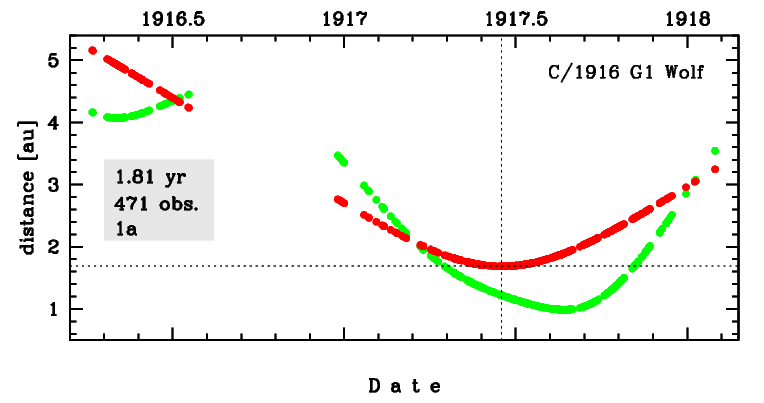C/1916 G1 Wolf
more info
Comet C/1916 G1 was discovered on 4 April 1916 by Max F.J.C. Wolf (Königstuhl Observatory, Heidelberg, Germany), that is about 14.5 months before its perihelion passage, and the comet was last seen on 29 January 1918 [Kronk, Cometography: Volume 3].
This comet made its closest approach to the Earth on 21 August 1917 (0.988 au), that is about two months after its perihelion passage.
Solutions given here are based on data spanning over 1.81 yr in a range of heliocentric distances from 5.16 au through perihelion (1.69 au) to 3.25 au.
Pure gravitational orbit determined from all available positional measurements (469 observations) give 1a-class orbit, orbit given in Minor Planet Center is 2A class (186 obs. used, almost the same arc of data; see MPC).
It was possible to determine the non-gravitational orbit for C/1916 G1 (preffered orbit), the RMS for NG orbit decreases from 1.97 arcsec (pure gravitational orbit) to 1.84 arcs.
This Oort spike comet suffers moderate planetary perturbations during its passage through the planetary system that lead to a more tight future orbit with semimajor axis of about 1300 au (see future barycentric orbits given here for both solutions: pure gravitational and non-gravitational).
More details in Królikowska et al. 2014.
This comet made its closest approach to the Earth on 21 August 1917 (0.988 au), that is about two months after its perihelion passage.
Solutions given here are based on data spanning over 1.81 yr in a range of heliocentric distances from 5.16 au through perihelion (1.69 au) to 3.25 au.
Pure gravitational orbit determined from all available positional measurements (469 observations) give 1a-class orbit, orbit given in Minor Planet Center is 2A class (186 obs. used, almost the same arc of data; see MPC).
It was possible to determine the non-gravitational orbit for C/1916 G1 (preffered orbit), the RMS for NG orbit decreases from 1.97 arcsec (pure gravitational orbit) to 1.84 arcs.
This Oort spike comet suffers moderate planetary perturbations during its passage through the planetary system that lead to a more tight future orbit with semimajor axis of about 1300 au (see future barycentric orbits given here for both solutions: pure gravitational and non-gravitational).
More details in Królikowska et al. 2014.
| solution description | ||
|---|---|---|
| number of observations | 471 | |
| data interval | 1916 04 07 – 1918 01 29 | |
| data type | perihelion within the observation arc (FULL) | |
| data arc selection | entire data set (STD) | |
| range of heliocentric distances | 5.16 au – 1.69 au (perihelion) – 5.74 au | |
| type of model of motion | NS - non-gravitational orbits for standard g(r) | |
| data weighting | YES | |
| number of residuals | 817 | |
| RMS [arcseconds] | 1.84 | |
| orbit quality class | 1b | |
| previous orbit statistics, both Galactic and stellar perturbations were taken into account | ||
|---|---|---|
| no. of returning VCs in the swarm | 5001 | * |
| no. of escaping VCs in the swarm | 0 | |
| no. of hyperbolas among escaping VCs in the swarm | 0 | |
| previous reciprocal semi-major axis [10-6 au-1] | 57.37 – 69.68 – 81.78 | |
| previous perihelion distance [au] | 2.1 – 2.5 – 3 | |
| previous aphelion distance [103 au] | 24 – 29 – 35 | |
| time interval to previous perihelion [Myr] | 1.4 – 1.7 – 2.3 | |
| percentage of VCs with qprev < 10 | 96 | |
| percentage of VCs with qprev > 20 | 4 | |
| previous_g orbit statistics, here only the Galactic tide has been included | ||
|---|---|---|
| no. of returning VCs in the swarm | 5001 | * |
| no. of escaping VCs in the swarm | 0 | |
| no. of hyperbolas among escaping VCs in the swarm | 0 | |
| previous reciprocal semi-major axis [10-6 au-1] | 57.39 – 69.68 – 81.77 | |
| previous perihelion distance [au] | 2 – 2.2 – 2.8 | |
| previous aphelion distance [103 au] | 24 – 29 – 35 | |
| time interval to previous perihelion [Myr] | 1.4 – 1.7 – 2.3 | |
| percentage of VCs with qprev < 10 | 100 | |
